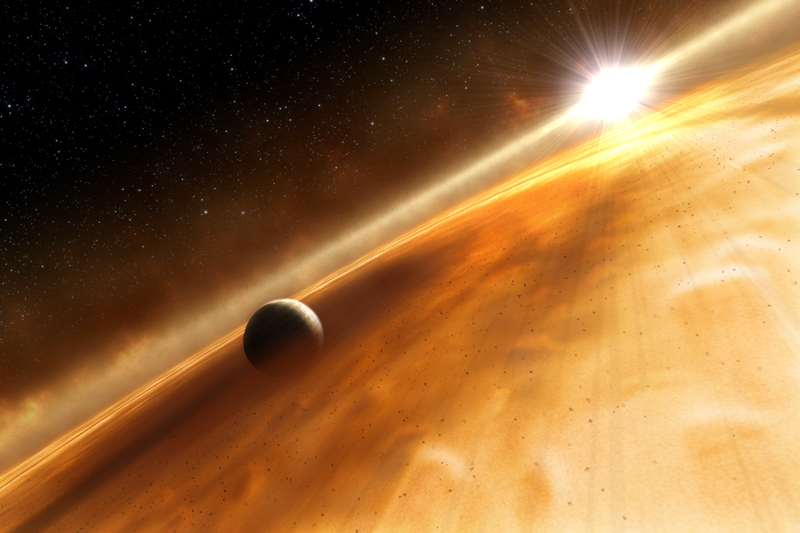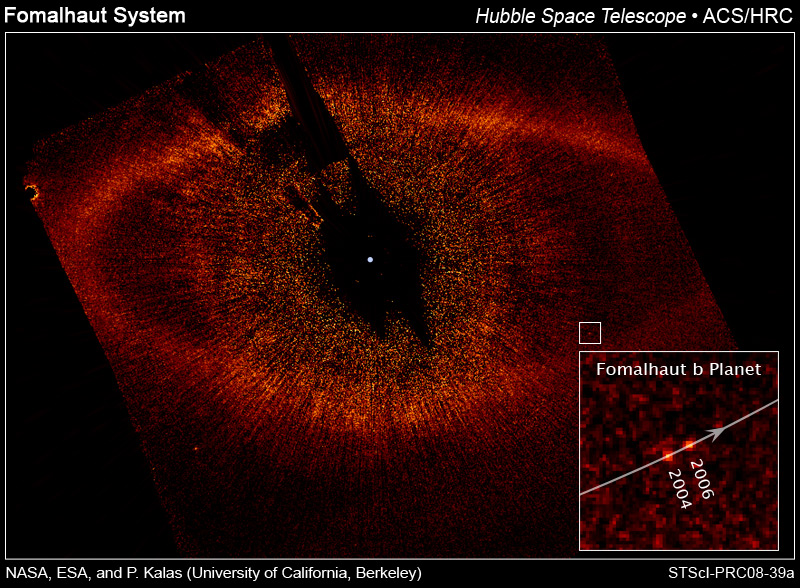Astronomy

 The image on the left is the first visible-light photograph of a planet orbiting another star, an extrasolar planet. It was taken by the Hubble Space Telescope. The planet, named Fomalhaut b, orbits the star Fomalhaut. Fomalhaut b is about three times the mass of Jupiter, is located 25 light-years away, and is estimated to be 100 million years old.
The image on the left is the first visible-light photograph of a planet orbiting another star, an extrasolar planet. It was taken by the Hubble Space Telescope. The planet, named Fomalhaut b, orbits the star Fomalhaut. Fomalhaut b is about three times the mass of Jupiter, is located 25 light-years away, and is estimated to be 100 million years old.
The first evidence for the planet came in 2004, when an earlier image by the Hubble Space Telescope of Fomalhaut revealed a ring of protoplanetary debris, having a defined inner edge, very similar to the Kuiper Belt around the solar system. In 2005, a team at the University of California at Berkeley proposed that this ring of debris was being affected gravitationally by a planet in between the star and inner edge of the ring.
The Hubble Space Telescope has now photographed a point of light believed to be the planet Fomalhaut b in that debris. The point lies 1.8 billion miles inside the inner edge of the ring.
Even though the object photographed is a billion times fainter than the star Fomalhaut, it is still brighter than what is expected from a planet three times the size of Jupiter. A possible explanation for this is that the planet has a ring of ice and dust orbiting it reflecting light, like Saturn does, which may later coalesce to form moons.
By comparing images from 2004 and 2006, the team was able to calculate the orbital period of the object. Using Kepler's laws of planetary motion, this came out to an 872-year-long orbit.
Further observations of the planet will reveal more information about the planet, such as a more accurate mass.
For more information, visit:
Images: NASA
- Hubble Finds A Planet With A Tail Like A Comet
Hubble Space telescope has discovered a planet which has a tail like a comet! HD 209458b planet is about 153 light years and was found in the year 2003. Scientists have measured the gas coming out from the planet. Scientists have used Hubble to find...
- Rocky Earthlike Planet Discovered
Researchers on 21.4.09 confirmed the existence of a rocky Earthlike planet with a mass of 1.9 Earth masses, orbiting in the Gliese 581 system. Another planet in the four planet system was also found to be lying in the star's habitable zone, the...
- A Planet With A Tail
An artist's interpretation of how extrasolar planet HD 209458b may look. Image: NASA, ESA, and G. Bacon (STScL) A giant gas extrasolar planet, HD 209458b, has recently been confirmed to possess a tail, resembling something like that of a comet. The...
- Another Extrasolar Planet
The picture above is the first picture of a planet (top-left) orbiting a sun-like star. It was taken by the 270-inch diameter Gemini North Telescope, located on Mauna Kea in Hawaii. The star, 1RXS J160929.1-210524, is located in the Scorpius constellation,...
- Saturn's Outer Ring Is 270 Times Bigger Than Thought
Researchers have found that the faint outermost ring of Saturn is much bigger than had been previously thought. In 2009, astronomers have discovered that there was an outer ring circling Saturn that had not been known to exist, made mostly of extremely...
Astronomy
Hubble Takes First Image of an Extrasolar Planet

An artist's concept of Fomalhaut b
 The image on the left is the first visible-light photograph of a planet orbiting another star, an extrasolar planet. It was taken by the Hubble Space Telescope. The planet, named Fomalhaut b, orbits the star Fomalhaut. Fomalhaut b is about three times the mass of Jupiter, is located 25 light-years away, and is estimated to be 100 million years old.
The image on the left is the first visible-light photograph of a planet orbiting another star, an extrasolar planet. It was taken by the Hubble Space Telescope. The planet, named Fomalhaut b, orbits the star Fomalhaut. Fomalhaut b is about three times the mass of Jupiter, is located 25 light-years away, and is estimated to be 100 million years old.The first evidence for the planet came in 2004, when an earlier image by the Hubble Space Telescope of Fomalhaut revealed a ring of protoplanetary debris, having a defined inner edge, very similar to the Kuiper Belt around the solar system. In 2005, a team at the University of California at Berkeley proposed that this ring of debris was being affected gravitationally by a planet in between the star and inner edge of the ring.
The Hubble Space Telescope has now photographed a point of light believed to be the planet Fomalhaut b in that debris. The point lies 1.8 billion miles inside the inner edge of the ring.
Even though the object photographed is a billion times fainter than the star Fomalhaut, it is still brighter than what is expected from a planet three times the size of Jupiter. A possible explanation for this is that the planet has a ring of ice and dust orbiting it reflecting light, like Saturn does, which may later coalesce to form moons.
By comparing images from 2004 and 2006, the team was able to calculate the orbital period of the object. Using Kepler's laws of planetary motion, this came out to an 872-year-long orbit.
Further observations of the planet will reveal more information about the planet, such as a more accurate mass.
For more information, visit:
- The HubbleSite News Release
Images: NASA
- Hubble Finds A Planet With A Tail Like A Comet
Hubble Space telescope has discovered a planet which has a tail like a comet! HD 209458b planet is about 153 light years and was found in the year 2003. Scientists have measured the gas coming out from the planet. Scientists have used Hubble to find...
- Rocky Earthlike Planet Discovered
Researchers on 21.4.09 confirmed the existence of a rocky Earthlike planet with a mass of 1.9 Earth masses, orbiting in the Gliese 581 system. Another planet in the four planet system was also found to be lying in the star's habitable zone, the...
- A Planet With A Tail
An artist's interpretation of how extrasolar planet HD 209458b may look. Image: NASA, ESA, and G. Bacon (STScL) A giant gas extrasolar planet, HD 209458b, has recently been confirmed to possess a tail, resembling something like that of a comet. The...
- Another Extrasolar Planet
The picture above is the first picture of a planet (top-left) orbiting a sun-like star. It was taken by the 270-inch diameter Gemini North Telescope, located on Mauna Kea in Hawaii. The star, 1RXS J160929.1-210524, is located in the Scorpius constellation,...
- Saturn's Outer Ring Is 270 Times Bigger Than Thought
Researchers have found that the faint outermost ring of Saturn is much bigger than had been previously thought. In 2009, astronomers have discovered that there was an outer ring circling Saturn that had not been known to exist, made mostly of extremely...
